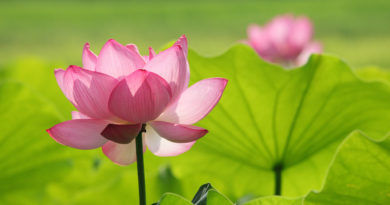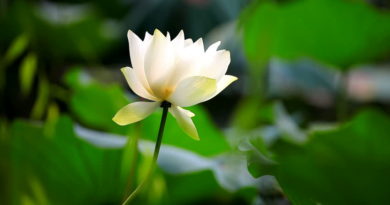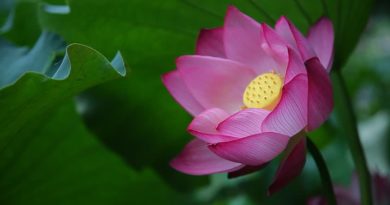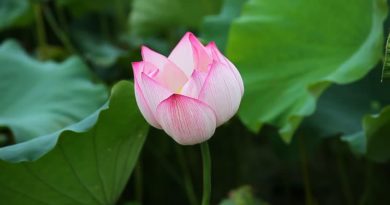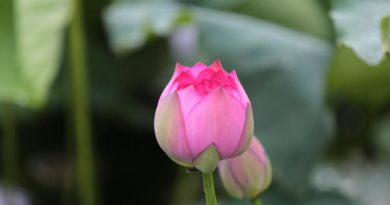THE JHĀNAS AND THE LAY DISCIPLE ACCORDING TO THE PĀLI SUTTAS – PART III: THE STREAM-ENTERER AND JHĀNA
THE JHĀNAS AND THE LAY DISCIPLE ACCORDING TO THE PĀLI SUTTAS – PART III: THE STREAM-ENTERER AND JHĀNA
The contention between the two parties in the contemporary debate might be recapitulated thus: Those who assert that jhāna is necessary for the attainment of stream-entry usually insist that a mundane (or form-sphere) jhāna must be secured before one can enter the supramundane path. Those who defend the dry-insight approach hold that a mundane jhāna is not indispensable, that a lower degree of concentration suffices as a basis for the cultivation of insight and the attainment of the path. Both parties usually agree that jhāna is part of the actual path experience itself. The issue that divides them is whether the concentration in the preliminary portion of the path must include a jhāna.
To decide this question, I wish to query the texts themselves and ask whether they show us instances of stream-enterers who are not attainers of the jhānas. Now while there are no suttas which flatly state that it is possible to become a stream-enterer without having attained at least the first jhāna, I think there are several that imply as much.
(1) Let us start with the Cūḷadukkhakkhandha Sutta (MN No. 14). The sutta opens when the Sakyan lay disciple Mahānāma, identified by the commentary as a once-returner, comes to the Buddha and presents him with a personal problem. Although he has long understood, through the guidance of the teaching, that greed, hatred, and delusion are corruptions of the mind (cittassa upakkilesa), such states still arise in him and overpower his mind. This troubles him and makes him wonder what the underlying cause might be. In his reply the Buddha says: “Even though a noble disciple has clearly seen with perfect wisdom that sensual pleasures give little satisfaction and are fraught with suffering and misery, rife with greater danger, if he does not achieve a rapture and happiness apart from sensual pleasures, apart from unwholesome states, or something more peaceful than this, then he is not beyond being enticed by sensual pleasures.”[24] The first part of this statement implies that the subject is at least a stream-enterer, for he is referred to as a “noble disciple” (ariya-sāvaka). Though the term ariya-sāvaka is occasionally used in a loose sense that need not be taken to imply attainment of stream-entry, here the expression “seeing with perfect wisdom” seems to establish his identity as at least a stream-enterer. Yet the second part of the statement implies he does not possess even the first jhāna, for the phrase used to describe what he lacks (“a rapture and happiness apart from sensual pleasures, apart from unwholesome states”) precisely echoes the wording of the basic formula for the first jhāna. The state “more peaceful than that” would, of course, be the higher jhānas.
(2) At AN 5:179/III 211, the Buddha speaks, with reference to “a lay follower clothed in white” (gihī odātavasana), of four “pleasant dwellings in this very life pertaining to the higher mind” (cattāro ābhicetasikā diṭṭhadhamma-sukhavihārā). Now in relation to monks, the Nikāyas invariably use this expression to mean the four jhānas.[25] If it were considered commonplace, or even paradigmatic, for a lay noble disciple to attain the four jhānas, one would expect the Buddha to explain the above expression in the same way as he does for monks. But he does not. Rather, when he specifies what these “pleasant abidings” mean for the noble lay follower, he identifies them with the possession of the four “factors of stream-entry” (sotāpattiyaṅga), namely, confirmed confidence in the Buddha, the Dhamma, and the Sangha, and possession of “the virtues dear to the noble ones.” This difference in explanation has important ramifications and is indicative of major differences in expectations regarding lay followers and monks.
(3) At AN VI 10/III 284-88, the Sakyan noble Mahānāma again approaches the Buddha and inquires about the meditative practice of “a noble disciple who has reached the fruit and understood the message” (ariyasāvako āgataphalo viññātasāsano). Here again, it is clear from the epithets used that the question concerns a lay follower who has realized stream-entry or some higher stage. Further, at the end of each expository section, the Buddha stresses the ariyan stature of the disciple with the words: “This is called, Mahānāma, a noble disciple who among unrighteous humanity has attained righteousness, who among an afflicted humanity dwells unafflicted, who has entered the stream of the Dhamma and develops recollection of the Buddha” (and so for each object of recollection).[26]
In his reply the Buddha shows how the lay disciple takes up one of the six objects of recollection (cha anussati): the Three Jewels, morality, generosity, and the devas. As the disciple recollects each theme, his mind is not obsessed by lust, hatred, or delusion, but becomes upright (ujugata): “With an unright mind he gains the inspiration of the goal, the inspiration of the Dhamma, gladness connected with the Dhamma. When he is gladdened rapture arises, his body becomes tranquil, and he experiences happiness. For one who is happy the mind becomes concentrated.”[27] As this passage shows, contemplation based on the Buddha (and the other objects of recollection) culminates in samādhi, yet the nature of this samādhi is not elucidated by way of the jhāna formula. In fact, the Nikāyas never ascribe to these reflective contemplations the capacity to induce jhāna, and this is expressly denied in the Commentaries, which hold that because these meditation subjects involve intensive use of discursive thought they can lead only as far as access concentration (upacāra-samādhi).
It thus seems that the type of concentration typically available to a lay noble disciple at the stage of stream-entry or once-returning is access concentration. This, of course, does not mean that stream-enterers and once-returners don’t attain the jhānas, but only that the standard doctrinal structure does not ascribe the jhānas to them as essential equipment.
(4) Nor does the above sutta imply that a lay stream-enterer must remain content merely with excursions into access concentration and cannot develop the higher wisdom of insight. To the contrary, the Buddha includes the higher wisdom among the five excellent qualities he regularly ascribes to noble lay disciples: faith, virtue, learning, generosity, and wisdom.[28] In several suttas of the Sotāpatti-saṃyutta, generosity and wisdom even replace virtue as the fourth factor of stream-entry, faith being included by “confirmed confidence” in the Three Jewels.[29] We should note that we do not find among these qualities any mention of samādhi or a formula for the jhānas. Yet we see that wisdom is defined in exactly the same terms used to define the wisdom of a monk in training (sekha). It is “the noble wisdom that discerns the arising and passing away of things, that is noble and penetrative and leads to the complete destruction of suffering.”[30] Since the lay stream-enterer or once-returner is thus well equipped with the wisdom of insight but is not typically described as a jhāna attainer, this implies that attainment of jhāna is not normally expected or required of him. From this we can also conclude that at these early stages of the path liberative wisdom does not depend on a supporting base of jhāna.
(5) A text in the Sotāpatti-saṃyutta gives credit to this conclusion. At SN 55:40/V 398-99, the Buddha explains to the Sakyan Nandiya how a noble disciple dwells diligently (ariyasāvako appamādavihārī). He says that a noble disciple should not become complacent about possessing the four factors of stream-entry but should use these qualities as starting points for contemplation: “He is not content with his confirmed confidence in the Buddha (etc.), but strives further in seclusion by day and in retreat by night. As he dwells diligently, gladness arises … (as above) … for one who is happy the mind becomes concentrated. When the mind is concentrated, phenomena become manifest. It is with the manifestation of phenomena to him that he is reckoned as ‘one who dwells diligently.'”[31]
The expression “manifestation of phenomena” (dhammānaṃ pātubhāva) indicates that the disciple is engaged in contemplating the rise and fall of the five aggregates, the six sense bases, and so forth. Thus this passage shows how the disciple proceeds from concentration to insight, but it does not describe this concentration in terms suggesting it occurs at the level of jhāna. Since the sequence switches over from concentration to insight without mentioning jhāna, it seems that the concentration attained will be tantamount to access concentration, not jhāna, yet even this suffices to support the arising of insight.
Notes:
24. MN I 91.
25. See, e.g., MN I 356; AN 10:8/V 11, etc.
26. AN III 285, etc.: Ayaṃ vuccati Mahānāma ariyasāvako visamagatāya pajāya samappatto viharati, savyāpajjhāya pajāya avyāpajjho viharati, dhammasotaṃ samāpanno buddhānussatiṃ bhāveti.
27. Ibid: Ujugatacitto kho pana Mahānāma ariyasāvako labhati atthavedaṃ labhati dhammavedaṃ labhati dhammūpasaṃhitaṃ pāmujjaṃ; pamuditassa pīti jāyati, pītimanassa kāyo passambhati; passaddhakāyo sukhaṃ vediyati; sukhino cittaṃ samādhiyati.
28. Saddhā, sīla, suta, cāga, paññā. Sometimes learning is omitted, since this is not as integral to the ariyan character as the other four qualities.
29. See SN 55:32-33, 42-43; V 391-92, 401-2.
30. Udayatthagāminiyā paññāya samannāgato ariyāya nibbedhikāya sammādukkhakkhaya-gāminiyā.
31. SN V 398-99: Idha Nandiya ariyasāvako Buddhe aveccappasādena samannāgato hoti … So tena Buddhe aveccappasādena asantuṭṭho uttariṃ vāyamati divā pavivekāya rattiṃ paṭisallānāya. Tassa evaṃ appamattassa viharato pāmujjaṃ jāyati … sukhino cittaṃ samādhiyati. Samāhite citte dhammā pātubhavanti. Dhammānaṃ pātubhāvā appamādavihārī tveva saṅkhaṃ gacchati…. Evaṃ kho Nandiya ariyasāvako appamādavihārī hoti.


